Appam (also known as “palappam”) are tasty, lacy and fluffy pancakes or hoppers from the Kerala cuisine that are made from ground, fermented rice and coconut batter. Thin and crispy around the edges with soft fluffy center appam taste delicious when paired with vegetable stew for a hearty vegetarian breakfast. They also just so happen to be gluten-free and vegan.
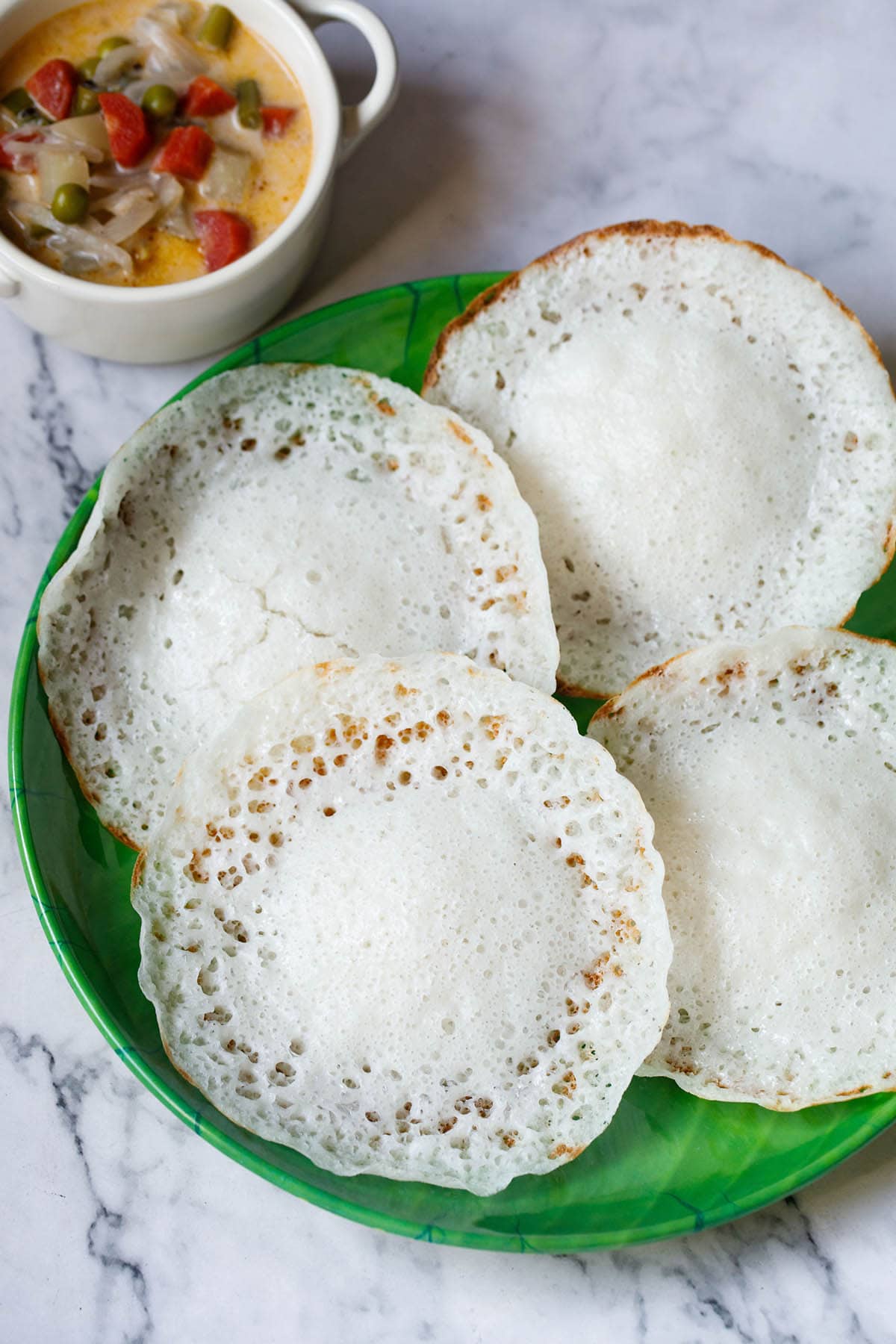
About Appam Recipe
Appam is one of our favorite breakfast dishes, so I make them on the weekends at least once a month. The preparation is similar to making Dosa Batter, and needs some prep work beforehand.
Traditionally, appam are fermented with a local alcoholic drink known as toddy – which is a drink made from palm flower or coconut flower.
Toddy, which is made from palm flower or coconut flower, is also known as “kallu” in Tamil and Malayalam or “tadi” in Hindi.
Since toddy is not readily available everywhere, I make these appam with yeast. Both dry active yeast and instant yeast works as a good fermenting agent and is easy to find the world over. This, however, does not mean that you cannot make appams without yeast.
Please note that there will be some flavor differences between appam made with toddy versus those made with yeast.
Appam can be made both dry active yeast or instant yeast (rapid rise yeast). I use either depending on what is there on hand. With instant yeast the fermentation time is very less as compared to fermentation with dry active yeast.
Table of Contents
In this post I share both the methods of making palappam with these two types of yeast. The instant yeast is directly added to the batter. If using dry active yeast activate it in lukewarm water and then add it to the batter later.
To make these appam, I opted to add fresh grated coconut while grinding the batter instead of coconut milk. You can use coconut milk instead of grated coconut – about 1 cup of thick coconut milk will suffice.
Appams are served with vegetable stew, kadala curry (chickpea curry), potato stew, vegetable korma, coconut chutney or coconut milk sweetened with jaggery.
To make my favorite sweet coconut milk for pairing with palappam, the coconut milk is sweetened with jaggery and flavored with cardamom powder.
Pour the desired amount of coconut milk you wish to sweeten into a cup. Add powdered jaggery to taste, along with a bit of cardamom powder. Stir very well until the jaggery is dissolved. Enjoy!
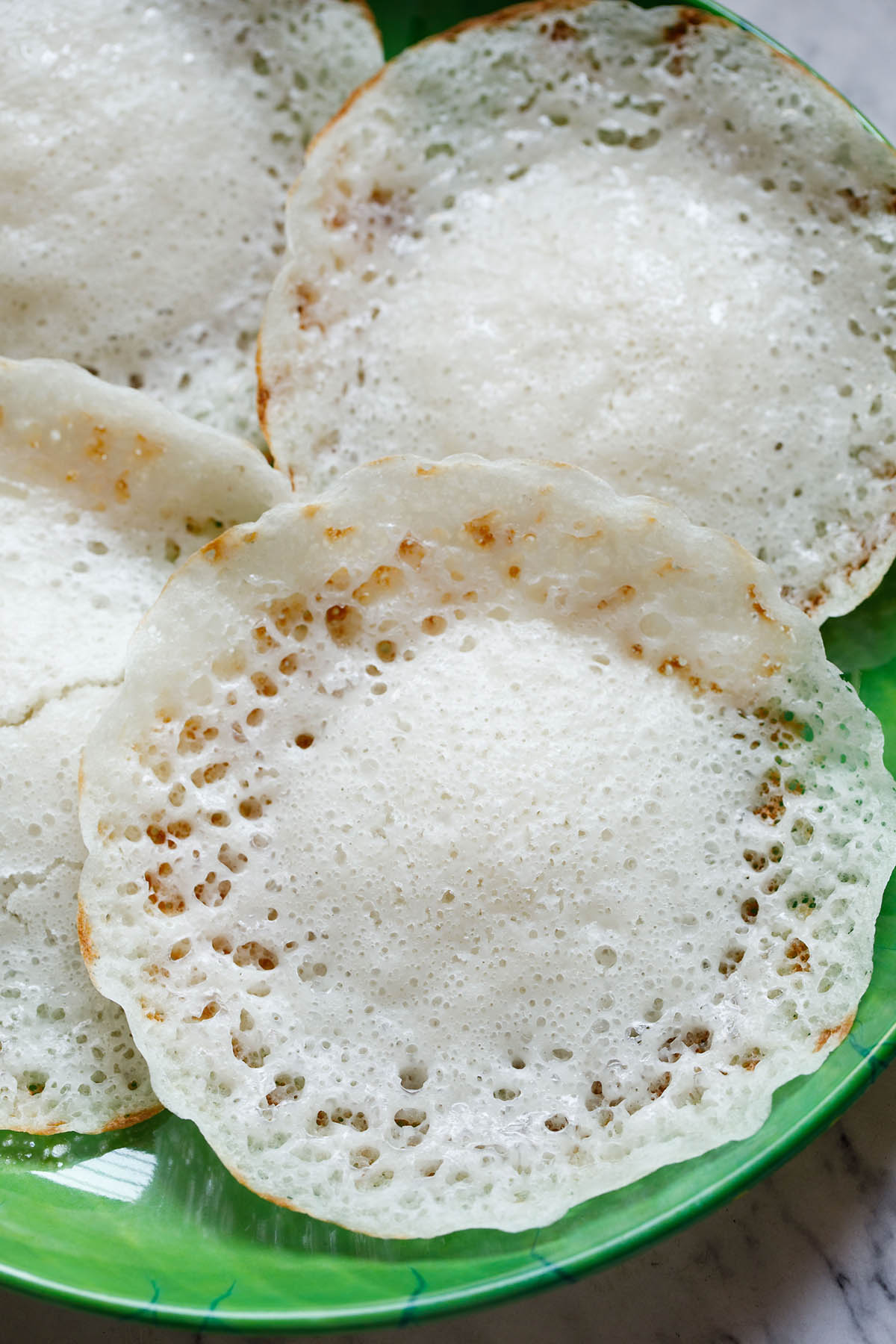
How to Make Appam Recipe
Make Palappam Batter
1. First rinse 1.5 cups regular white rice (like sona masuri, parmal, surti kolam, or ponni rice) in water a few times. Then soak the rice with 2 cups of water in a bowl for 4 to 5 hours. While soaking cover with a lid.
You can use half-half of regular raw rice and parboiled rice. Here I have used sona masuri rice.
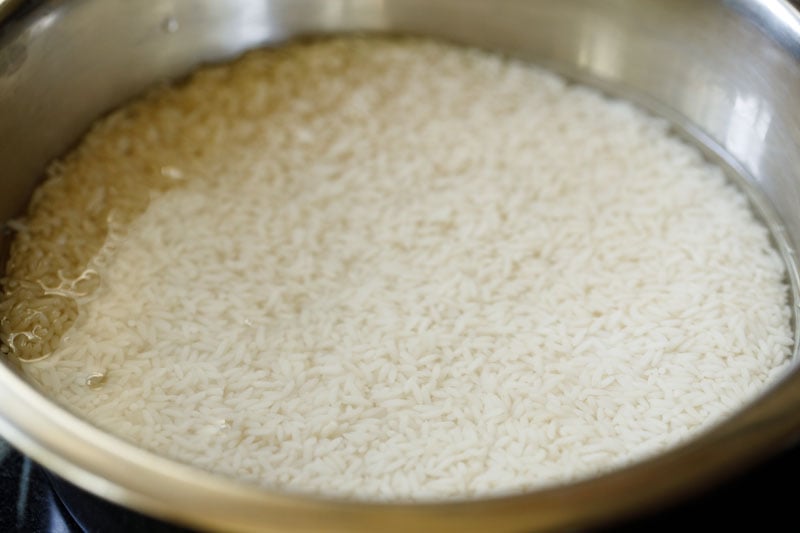
2. Drain all the water and discard it. Add the drained, soaked rice to blender or grinder jar. Also add ½ cup grated fresh coconut, ¼ cup poha (flattened rice), ½ teaspoon salt and 2 tablespoons sugar.
Instead of flattened rice (poha or aval), you can use cooked or steamed rice or puffed rice (murmura).
You could opt to soak the aval or poha with the rice or separately for 30 minutes or add them to the blender after rinsing with water.
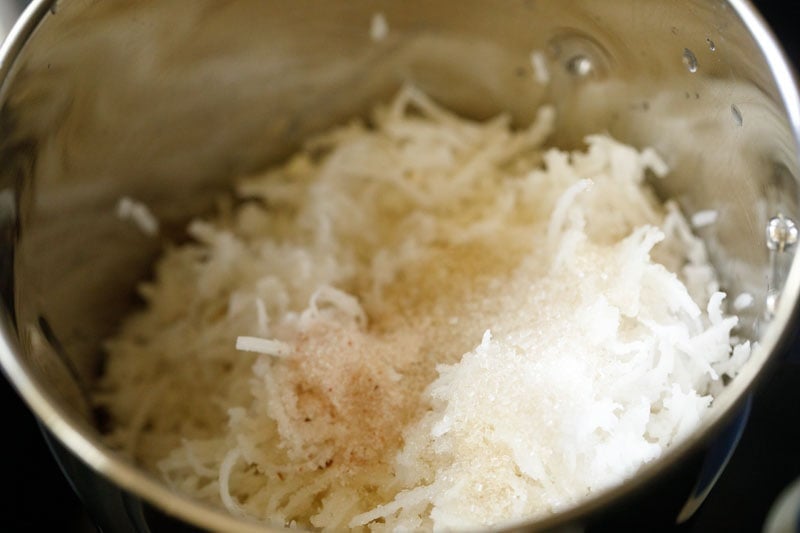
3. Add ¾ cup water (or as needed) and blend or grind the ingredients to a smooth and fine flowing batter.
If in case, the batter looks thin, add a few tablespoons of rice flour to thicken it slightly.
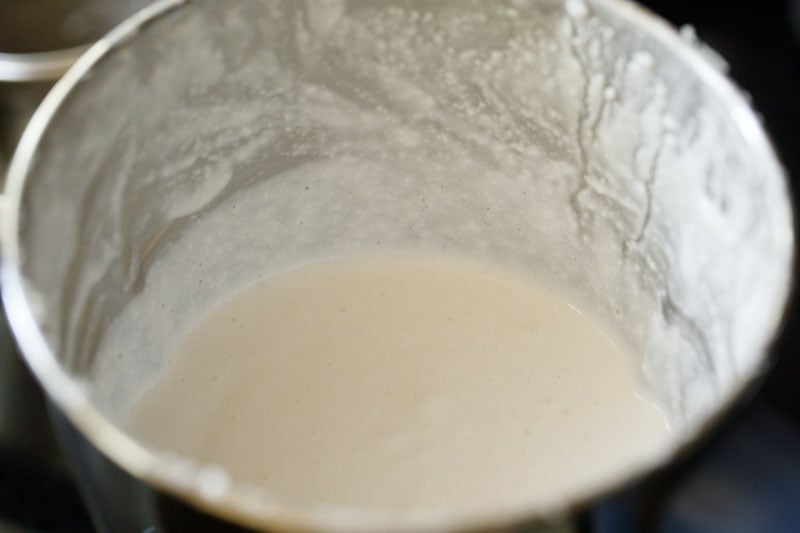
Leaven the Batter
Transfer the batter in a medium to large mixing bowl. Now you have two options when it comes to yeast. I have made this recipe many time with both the types of yeast.
With Instant yeast, the recipe just gets made quicker as the leavening and fermenting time reduces. I have included instructions for both.
4a. If using Dry Active yeast
Mix ½ teaspoon dry active yeast first in 1 to 2 tablespoons of lukewarm water. Add this yeast solution to the batter and mix well. Cover and allow to ferment for 8 to 12 hours, depending on the temperature conditions. The batter will rise and double up the next day.
4b. If using Instant Yeast
Add ½ teaspoon Instant yeast (rapid rising yeast). I have used instant yeast here.
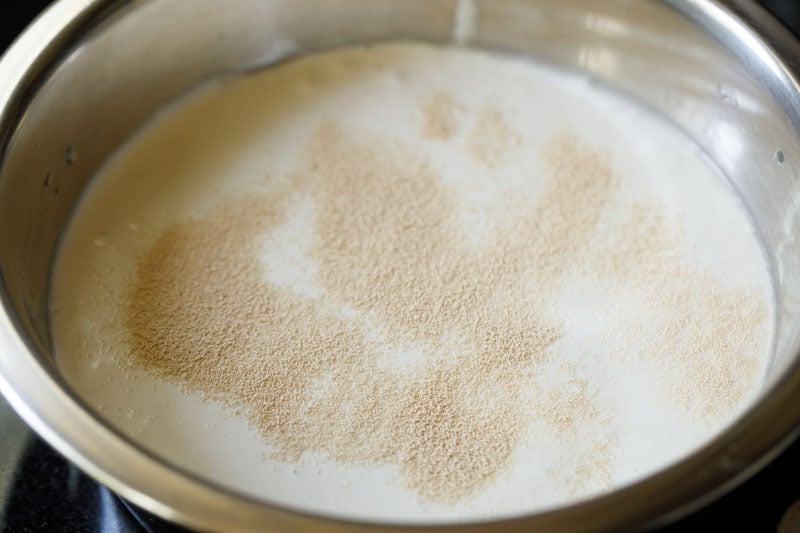
5. Mix thoroughly so that the fine yeast granules dissolves in the batter. Cover and set aside to ferment for 1 to 2 hours. You can also use the instant pot to ferment the batter.
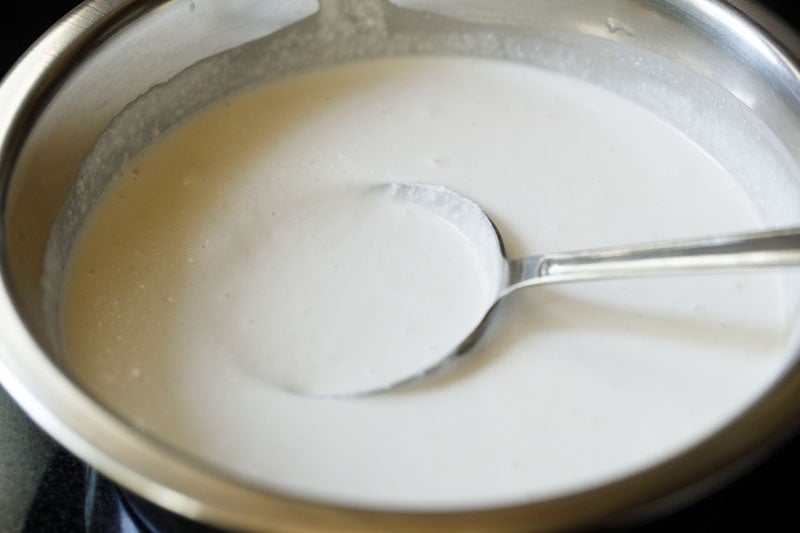
6. After leavening with instant yeast, this is how the batter should look. It will double in volume and you will see air-pockets everywhere.
I had to leaven the batter for a total of 1 hour and 15 minutes as it was a warm climate this day. A cooler weather will take more time.
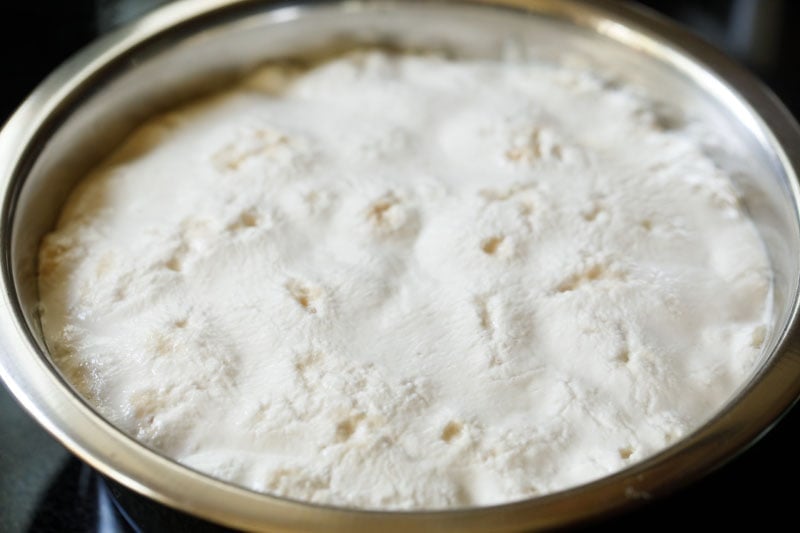
7. A well-fermented batter will have many tiny air-pockets.
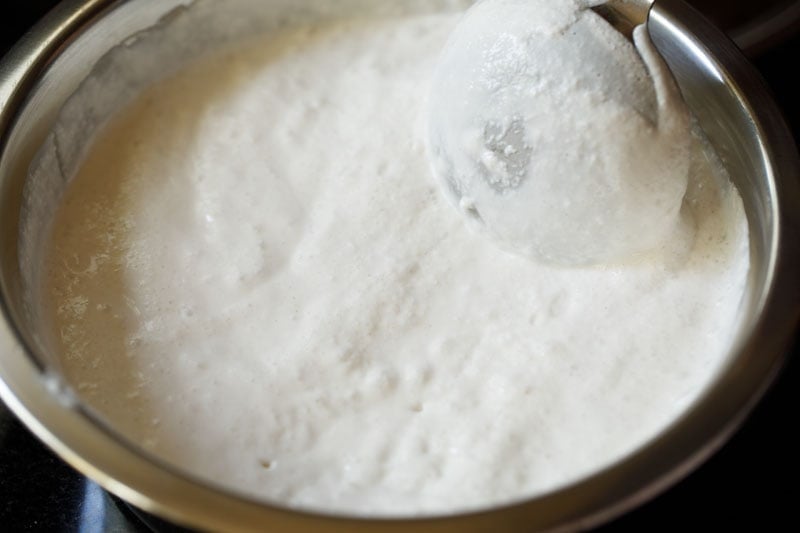
Make Appam
8. Heat an appam pan or a seasoned kadai/wok with handles. Sprinkle about ½ teaspoon oil on the pan and spread it all over on the pan. If using nonstick kadai, then skip smearing the oil.
The appam pan or appachatti works best as you get soft fluffy texture in the center and crisp texture towards the circumference. Spread a ladle full of the batter (about ¼ to ⅓ cup) into the hot pan.
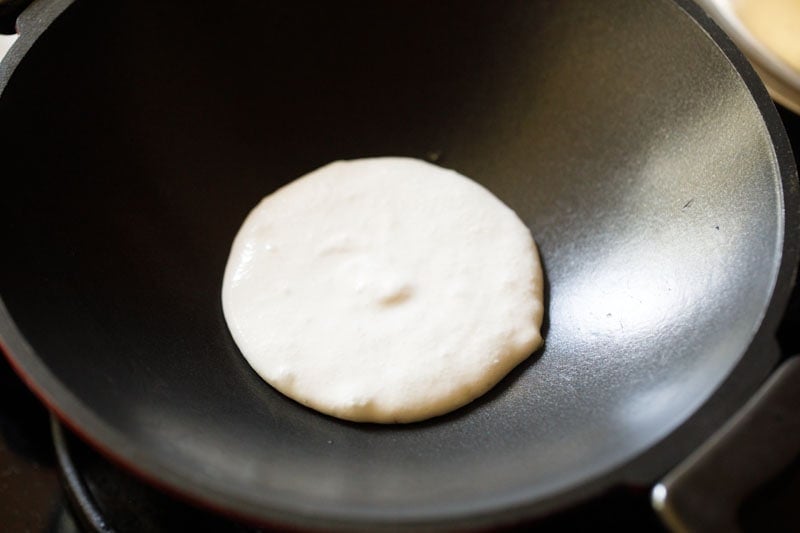
9. Turn and tilt the pan in circles so as to spread the batter into a round circle.
Regulate the heat as needed. If the pan becomes too hot, the batter cooks faster and you won’t be able to make a neat round batter with thin edges and a soft center. So you can reduce the heat or place the pan on the countertop and then pour the batter.
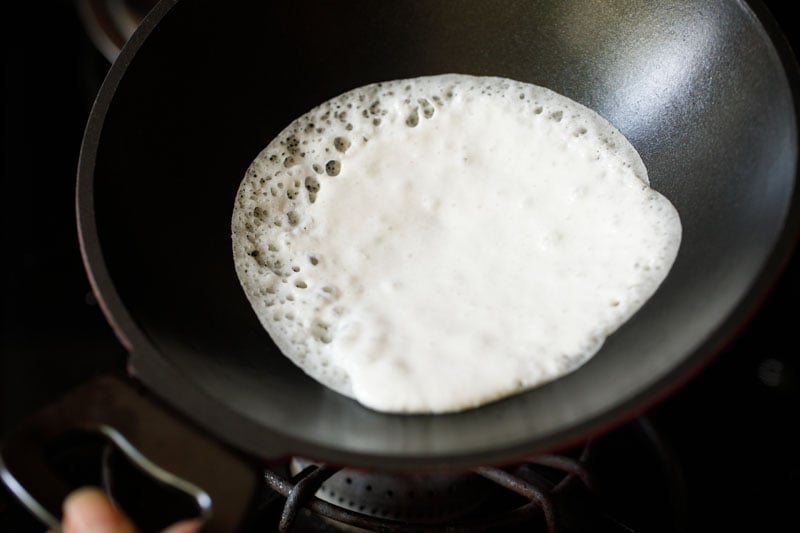
10. Make a neat round circle of the batter. Keep the heat to medium-low or medium.
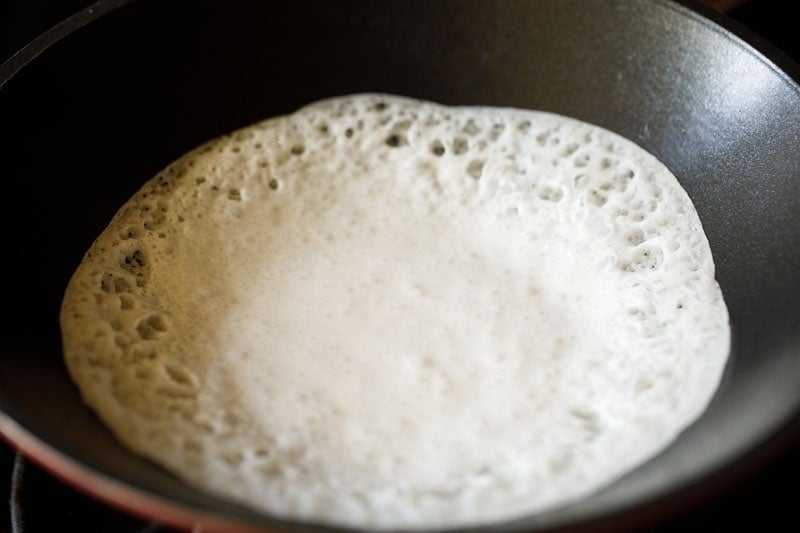
11. You can also drizzle a few drops of oil on the sides if you prefer.
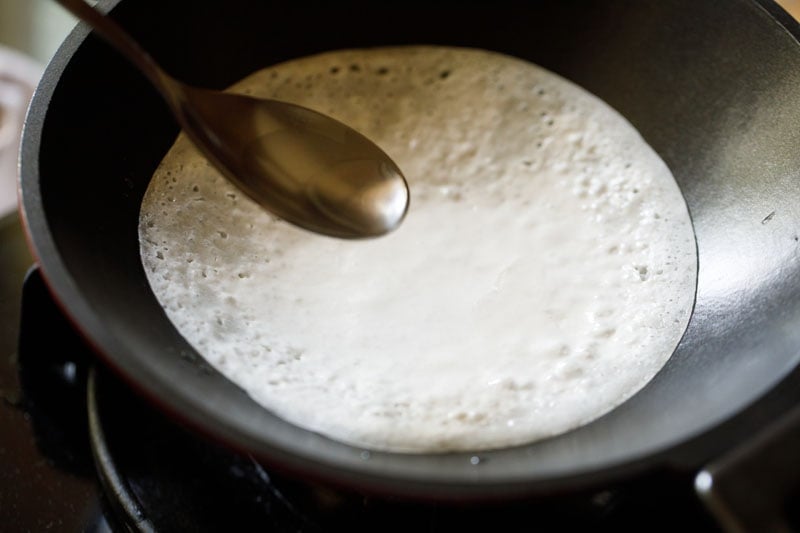
12. Cover the pan with lid and let the appam cook for about 2 minutes or until the base becomes nicely light golden and the center firms up and becomes soft and fluffy.
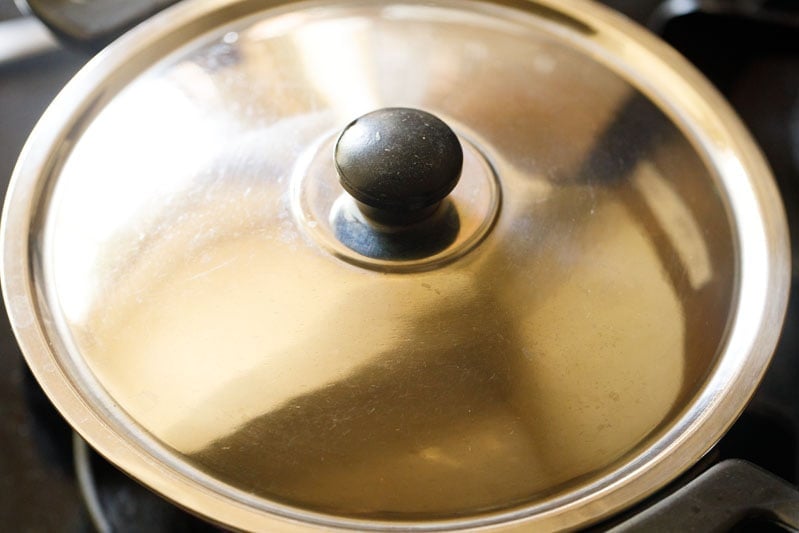
13. Remove and serve appam hot or warm. Repeat with remaining batter to make as may appam as you need. Store any remaining batter in the refrigerator and use within 1 day.
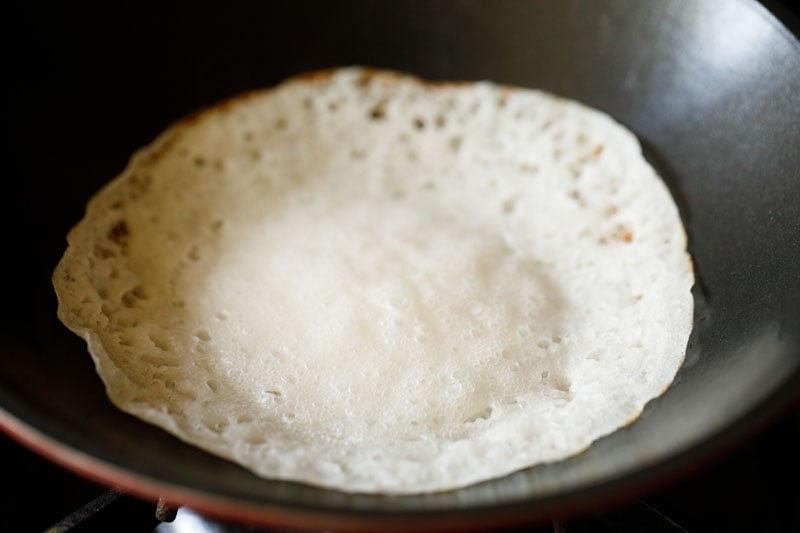
14. Appam goes very well with vegetable stew and sweetened coconut milk. I like to serve them with both! It can also be served with veg korma or potato stew.
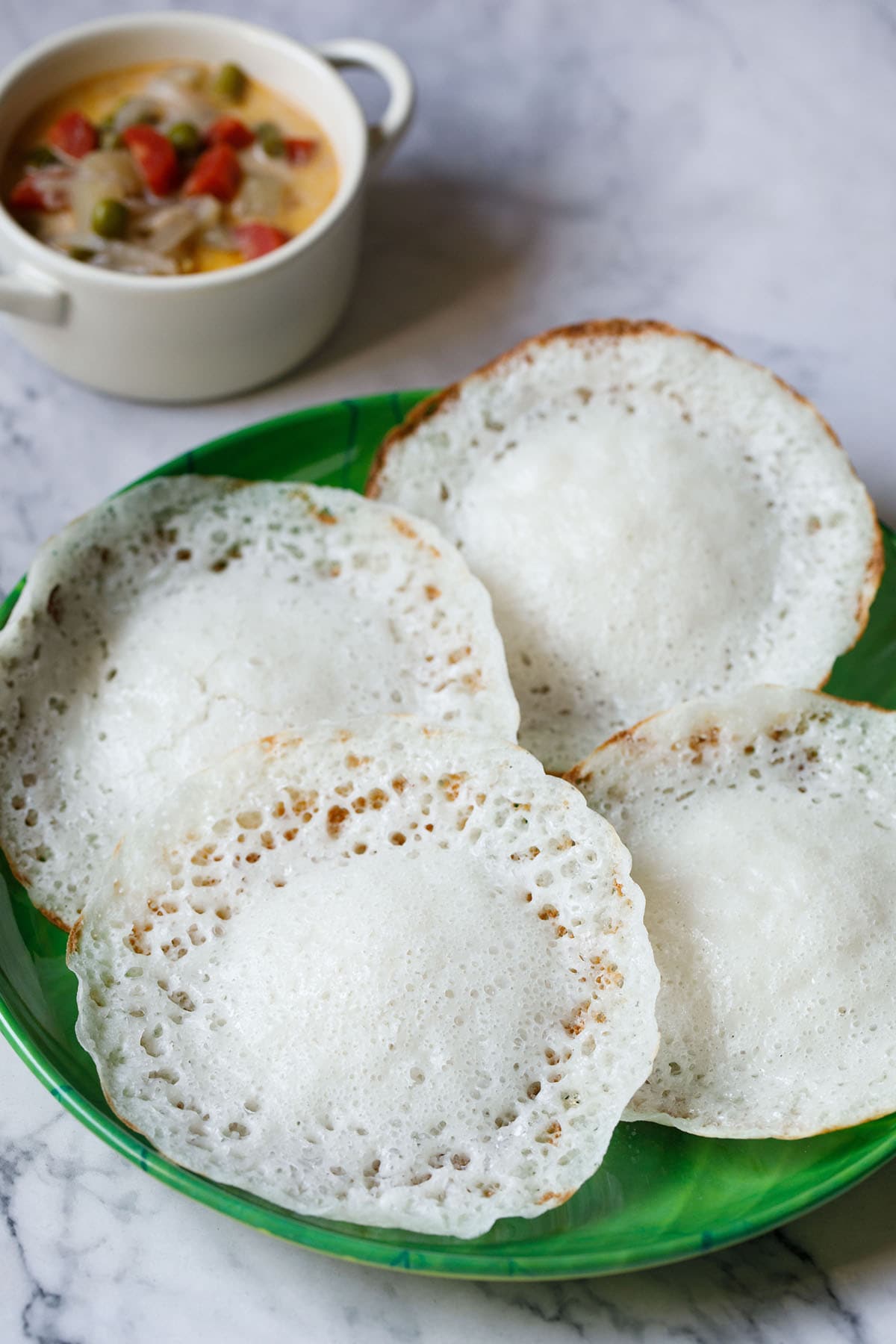
Palappam FAQs
Yeast requires a warm environment to thrive, so the room temperature will affect fermentation. If the room is chilly, you’ll need to allow more time for fermenting.
Alternatively, you can create a “proofing box” with your oven – simply place a cake pan or other deep dish on the bottom shelf of your oven. Place the batter on the top shelf, then close the door. This will provide a nice environment for the yeast to do its work! Make sure the oven is switched off.
Salt can affect fermentation, so my recommendation is:
If you live in a warm or hot climate, then add salt before to avoid over fermentation.
If you live in a cool or cold place, then add salt once the batter is fermented.
Oops! Sounds like you added a bit too much water, making the batter too thin. Next time, reduce the amount of water you add when grinding. To fix this batch, try adding rice flour by the tablespoon until you achieve the batter consistency shown in the photos above.
Uh-oh! Sounds like you over-fermented the batter. Try using the batter at an earlier stage, per the photos in the step-by-step instructions above.
I recommend 2 to 3 appam per person.
Appam batter will last in the fridge for 1 day; any longer and it will begin to turn sour.
As you cook the appam, layer each with a sheet of parchment before stacking another on top.
I suggest any short or medium grain variety of rice, but you can also use a longer grain rice like basmati. Just note that longer grain rice will yield a slightly different consistency than medium or short grained.
You can use desiccated coconut, but the flavor will be different than fresh. You can swap in frozen coconut, though!
More South Indian Breakfast Recipes
Breakfast Recipes
Breakfast Recipes
Karnataka Recipes
Gluten Free Recipes
Please be sure to rate the recipe in the recipe card or leave a comment below if you have made it. For more vegetarian inspirations, Sign Up for my emails or follow me on Instagram, Youtube, Facebook, Pinterest or Twitter.
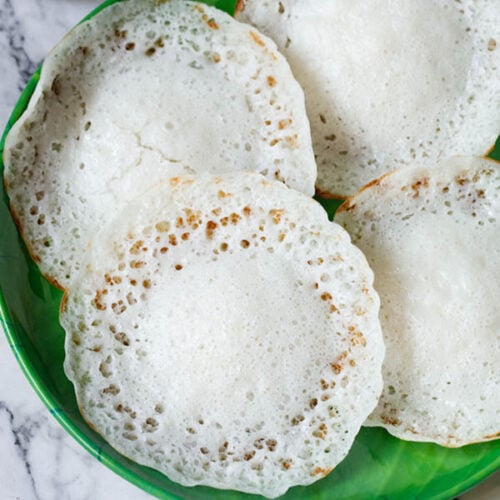
Appam Recipe
Ingredients
- 1.5 cups regular rice or parboiled or half-half of both types
- 2 cups water – for soaking
- ¼ cup thick poha (aval or flattened rice) or cooked rice or puffed rice
- ½ cup grated fresh coconut
- ¾ cup water or as needed for blending or grinding batter
- ½ teaspoon instant yeast or ¾ teaspoon dry active yeast
- ½ teaspoon salt or add as required
- 2 tablespoons sugar or add as required
Instructions
- Rinse rice in water for a couple of times.
- Soak rice in water for 4 to 5 hours.
- Drain all the water and then add the soaked rice to mixer-grinder or blender jar. Also add the grated coconut, cooked rice or poha (aval or flattened rice), salt and sugar.
- You could opt to soak the aval or poha with the rice or separately for 30 minutes or add them to the blender after rinsing with water.
- Add water and grind all the ingredients to a smooth flowing batter
- Transfer the batter in a medium to large bowl.
- With Instant Yeast: Sprinkle the Instant yeast (or rapid rising yeast) all over the batter. Mix thoroughly and evenly. Cover the bowl and set aside to ferment for 1 to 2 hours until the batter doubles in volume and has plenty of air-pockets.
- With Dry Active Yeast: Take about 1 to 2 tablespoons of lukewarm water in a bowl. Then add the dry active yeast and stir to mix well. Add this yeast solution to the batter and mix thoroughly. Cover and keep aside for fermenting overnight or for 8 to 12 hours or more depending on the temperature conditions. The batter will rise and increase in volume the next day. * Check notes
- Heat a kadai or an appam pan with handles at the sides. Spread some oil on the appam pan with a spoon. If using nonstick pan, then skip smearing the oil.
- Spread a ladle full of the batter (about ⅓ to ¼ cup). Turn and tilt the pan so as to spread the batter to a neat round circle. Keep heat to medium-low or medium. Regulate the heat as needed when cooking.
- Drizzle some oil on the sides if you prefer.
- Cover the pan with a lid and let the appam cook. The base would become nicely light golden with crispy edges.
- Gently remove the cooked appam with a spatula. Make the remaining batches of appam this way. If the pan becomes too hot then reduce the heat so that the batter is easy to spread when you tilt the pan.
- Keep the prepared appams covered with a kitchen towel.
- Serve the appam hot or warm with vegetable stew or coconut milk that has been sweetened with jaggery and flavored with a bit of cardamom powder.
Notes
Nutrition Info (Approximate Values)
This Appam Recipe from the archives was first published in April 2014. It has been republished and updated on September 2021.
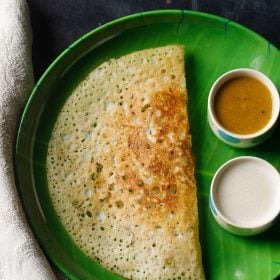

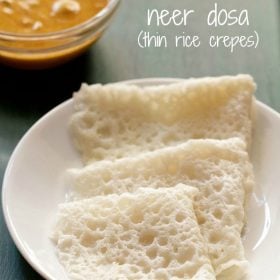
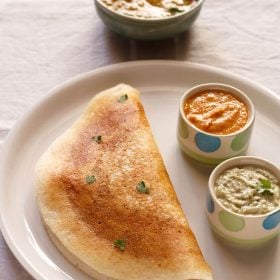
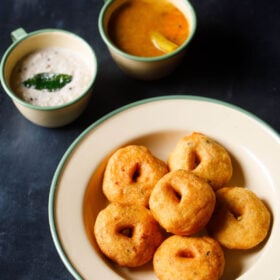
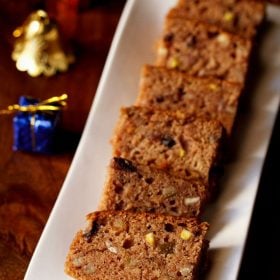
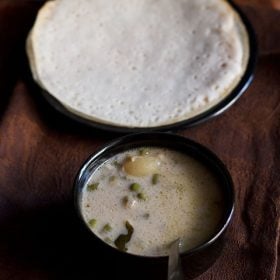
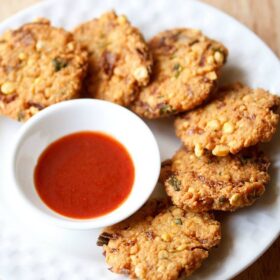








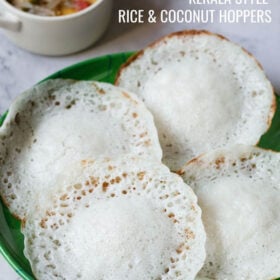
Can I use raw rice for the aapam recipe please?
Thank you!
Yes you can.
Thank you